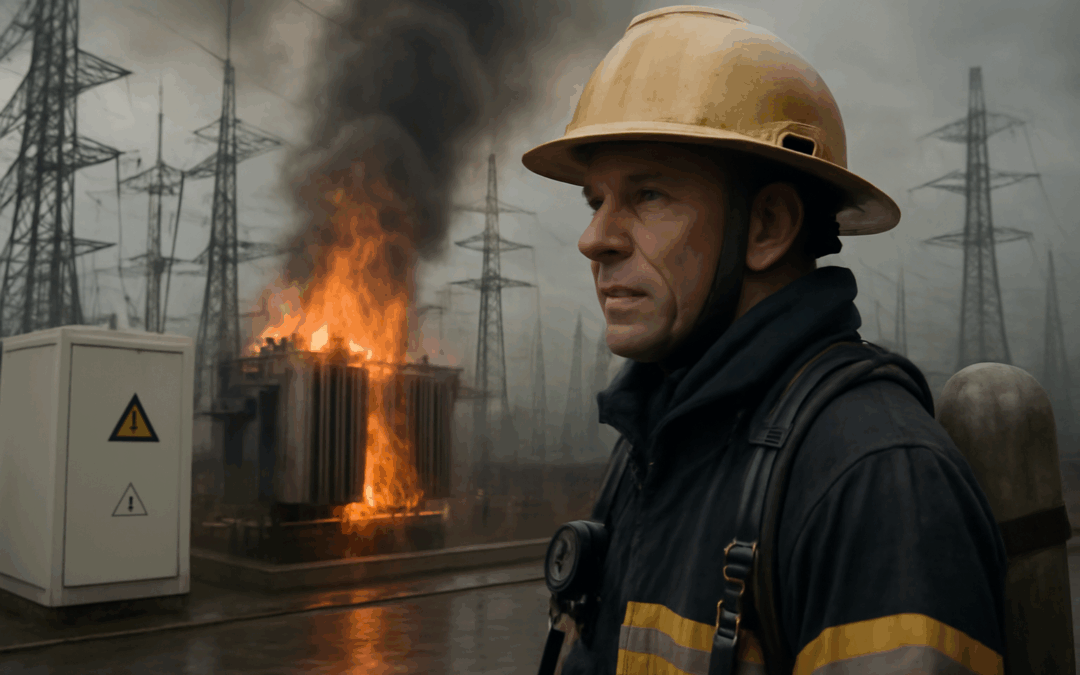The Future of Emergency Response: Energy Hazards, Lithium-Ion Batteries, and the Nation’s First Energy Response Team
How a Substation Fire Sparked a National First
When I spoke with Chris Green, he had just retired after 30 years at Seattle Fire, 16 of those as a captain. What started as a frustrating substation fire in 2014 – an incident that went sideways while he was on vacation, ended up igniting something much bigger: the country’s first energy response team.
“I was asked to smooth things over with City Light,” Chris told us. “But when I showed up, there were 13 people in a room with only 12 chairs. You knew you were screwed.”
That fire was mishandled. A capacitor bank filled with oil went up in smoke, and the response; hosing it down with a deck gun had only made things worse. But it also exposed a critical gap: traditional firefighting protocols simply weren’t built to handle the energy infrastructure that powers modern cities.
So instead of burying the incident, Seattle leaned into the lesson. Chris got a mandate to build a team with real capabilities, backed by real training. By 2018, Energy One was fully funded, fully staffed, and fully operational out of Station 25 in Seattle.
What Is an Energy Response Team?
Unlike hazmat or rescue squads, this team was built from scratch; no rulebook, no certification standard, no national model to copy. It was, as Chris put it, “just like hazmat in the ‘70s.”
Seattle’s energy response team is made up of 44 technicians, all trained in-house in partnership with Seattle City Light. These are not electricians. They’re firefighters who understand electrical energy well enough to make safe, life-or-death decisions inside energized environments.
Their specialty? Substations, underground vaults, switchgear rooms, overhead lines, solar systems, and residential energy storage systems – anything that can fry you before you know you’re in danger.
The goal isn’t just about having tools. It’s about understanding the context behind those tools: how energy flows, how it behaves, and what could go wrong.
“Stable or Unstable?” The Most Important Question in Energy Response
Chris hammered home one idea that stuck with me: before you can save someone in an energized space, you need to ask, is the energy stable?
This isn’t hazmat where something leaks, and you just plug the hole. Electricity doesn’t spill. It’s either on or off, and knowing the difference can be the line between a rescue and a body recovery.
He walked us through a situation where a utility worker collapses inside an underground vault. If the energy in the space is stable, meaning everything’s functioning correctly, then you might be able to safely perform a rescue. But if it’s unstable, say there’s a blown splice or arcing going on, you can’t just storm in and play hero.
Chris made it simple: “If the energy is driving the emergency, you’ve got a problem.”
Lithium-Ion Batteries: Not Just a Hazmat Issue
We touched on what’s arguably the hottest topic in fire service right now: lithium-ion batteries.
Chris is skeptical that lithium-ion automatically belongs to hazmat. “Is it hazmat just because it has lithium in it?” he asked. “There’s barely enough in there to scrape together dust.”
He makes a good point. Until about 2014, lithium-ion batteries were in everything; phones, laptops, power tools, and they’d been catching fire long before anyone flagged them as a hazmat concern.
Chris’s take is that hazmat got pulled into the battery discussion not because of the chemistry, but because hazmat techs are trained to think critically about unstable conditions. Not just react. That’s why they were first to handle thermal runaway and re-ignition threats. But long term? Chris thinks operations crews can handle most of it, if they’re trained properly.
Four Utilities Every Responder Needs to Know at a House Fire
Chris made a strong case that our approach to structure fires is stuck in the past. Today, when you show up to a house fire, there are potentially four separate energy sources you need to secure:
- Overhead utility drop
- Residential generator (like a Generac)
- Lithium-ion storage (garage battery)
- Rooftop solar (and the inverter)
Miss one, and that “secure” building might still be energized. And as Chris points out, the garage and the roof aren’t always connected. You need to check both.
It’s not the same job it was 30 years ago, and we’re still running plays from that playbook.
Why Every City Needs an Energy Program – Even Without a Team
Not every department has the resources to build a million-dollar rig like Energy One. That’s okay.
Chris isn’t saying every city needs a full technical team, but he is adamant that every city needs an energy response program – a way to train crews on:
- How to recognize energized environments
- What distances are safe for different voltages
- When to treat a space like a rescue and when to treat it like a death trap
- How to coordinate with utilities and know who to trust
In his words: “If you’re going to own energy, the first thing you do is widen up and ask, what the hell is energy?”
A National Problem Waiting for a National Answer
One of the more sobering points Chris made is that energy response right now depends heavily on local leadership. If your fire chief sees the value and pushes for it, you might get a program like Seattle. But if not? You’re on your own.
That’s dangerous. Because the energy infrastructure is the same across most U.S. cities. High voltage lines, battery storage, underground vaults – they don’t behave differently in Kansas City than they do in Seattle. But only one of those has a trained response team.
Until there’s national guidance or certification, departments have to take the initiative themselves.
Final Thoughts: It’s Time to Catch Up
What stood out most in this conversation is how far behind we are on understanding the risks we face every day. Whether it’s lithium batteries reigniting hours later, or transformers cooking underground, energy is part of nearly every alarm we run.
Chris Green didn’t invent a new hazard. He just stopped pretending we were already trained for it. That mindset could save a lot of lives – not just firefighters’, but the people we’re trying to help.


